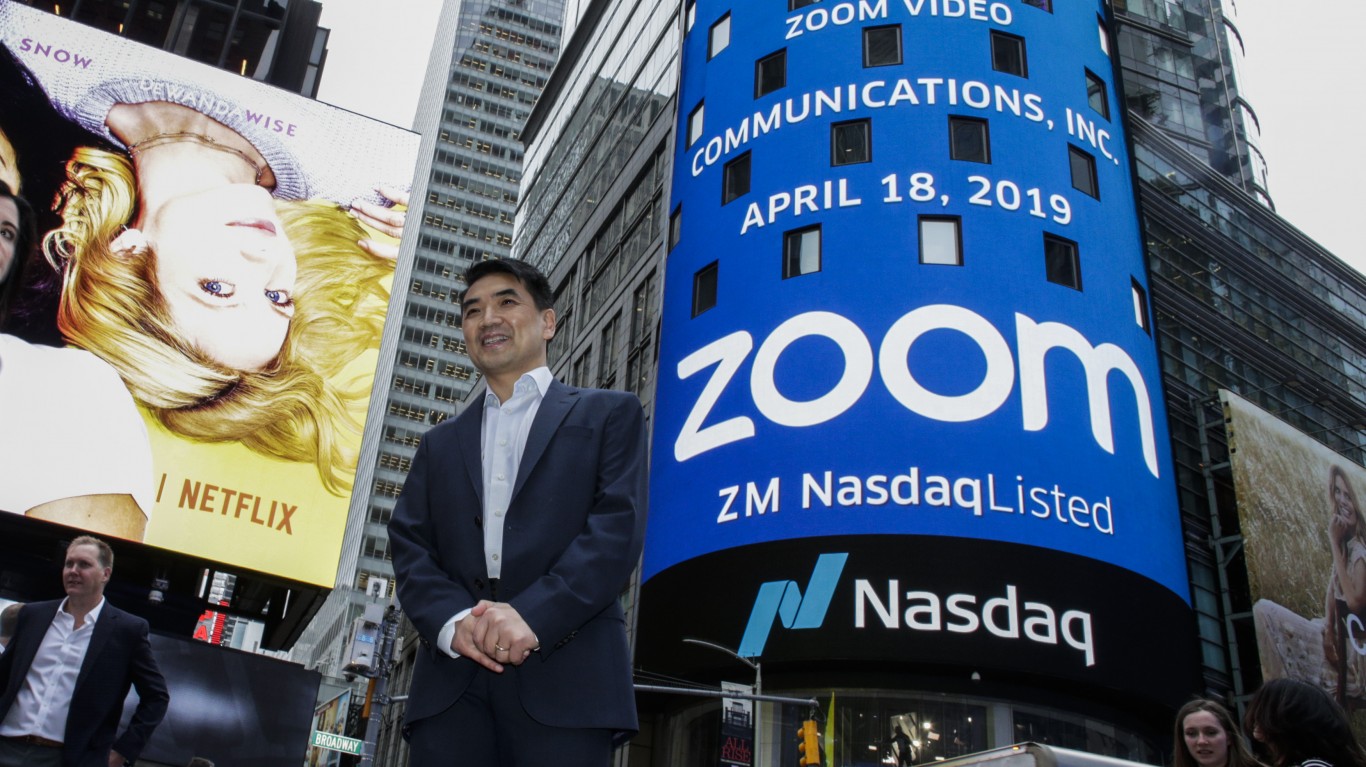
The three major U.S. equity indexes closed higher Friday. The Dow Jones industrials ended the day up 1.26%, the S&P 500 closed 1.36% higher and the Nasdaq saw a gain of 1.28%. All 11 sectors closed higher, with materials (3.41%) and financials (1.87%) posting the biggest gains. Utilities and healthcare (both 0.57%) had the smallest gains.
This week’s economic calendar includes the monthly report on the consumer price index (CPI). Economists are expecting the Thursday morning release to show that the index increased month over month in October by 0.7%. Core CPI (excluding food and energy) is expected to tick down from 0.6% to 0.5%. The weekly report on new claims for unemployment insurance will be released Wednesday. New claims are expected to rise from last week’s 217,000 to 220,000.
The three major indexes traded higher in Monday’s premarket session.
Before markets opened, Palantir Technologies reported a one-penny miss on EPS and revenue in line with expectations. The company lowered fourth-quarter revenue guidance to a new range of $603 to $505 million. Analysts had a consensus estimate of $506.6 million. The stock traded down about 2% in Monday’s premarket.
NiSource reported adjusted earnings per share (EPS) that met the consensus estimate, while revenue of $1.09 billion was better than expected. The company lowered full-year EPS guidance from a prior range of $1.50 to $1.57 to a new range of $144 to $1.46. NiSource also announced a growth plan that it expects to boost adjusted EPS by 6% to 8% annually through 2027. Shares traded down 1.1% Monday morning.
Ballard Power reported inline EPS and missed on revenue. Shares traded up about 0.7%.
Activision Blizzard and Lyft take their turns in the earnings spotlight after U.S. markets close on Monday. Before U.S. markets open on Tuesday, Constellation Energy and GlobalFoundries are on deck to report quarterly earnings.
Here is a preview of three companies set to report quarterly results after U.S. markets close on Tuesday.
Affirm
Since posting an annual high exactly one year ago, shares of payment processor Affirm Holdings Inc. (NASDAQ: AFRM) have dropped by around 90%. Most of that decline (84%) occurred this year. Affirm, a buy-now-pay-later lender, posted its 52-week low after reporting March-quarter earnings. The bad news continued with the June-quarter report, and expectations for the September quarter, the first of fiscal 2023 for Affirm, are not encouraging.
Of 18 analysts covering Affirm, eight have a Buy or Strong Buy rating and seven others rate the stock a Hold. At a recent share price of around $16.10, the implied gain based on a median price target of $28.50 is 77%. Based on the high price target of $53.00, the upside potential for the stock is nearly 230%.
Analysts expect Affirm to report fiscal first-quarter revenue of $360.47 million, which would down 1.0% sequentially but up 33.8% year over year. They also expect the company to report an adjusted loss per share of $0.88, worse than the prior quarter’s loss of $0.65 per share but better than the year-ago loss of $1.13 in the first quarter. For the full fiscal year ending in June, Affirm is expected to post a loss per share of $3.28, worse than last year’s loss of $2.51 per share, on revenue of $1.7 billion, up 26.1%.
Affirm is not expected to post a profit in 2023, 2024 or 2025. The enterprise value to sales multiple is expected to be 4.3 in 2023. Based on average estimated sales of $2.22 billion and $2.8 billion for 2023 and 2024, respectively, the multiple is 3.3 for 2023 and 2.6 for 2024. The stock’s 52-week trading range is $13.64 to $176.65. Affirm does not pay a dividend. Total shareholder return for the past year was negative 90.2%.
AMC Entertainment
Shares of AMC Entertainment Holdings Inc. (NYSE: AMC) have dropped by more than 86% over the past 12 months. The stock’s 52-week high was posted exactly a year ago, so it has been a rough year for the meme stock favorite, even including a couple of spikes in the share price. Since issuing preferred shares (NYSE: APE), those shares have dropped nearly 74%. The company noted in August that the September quarter lacked big movie releases and would have a negative effect on revenues. That appears to be what investors expect too.
AMC is not an analyst’s favorite. Just eight brokerages cover the stock, and none has a Buy or Strong Buy rating. Only three rate the shares at Hold. At a price of around $5.50 a share, the stock trades more than three times higher than its median price target of $1.60. At the high price target of $7.50, the upside potential is 36.4%.
Third-quarter revenue is forecast at $960.97 million, down 17.6% sequentially but 25.9% higher year over year. Analysts expect AMC to report a loss per share in the quarter of $0.24, worse than the prior quarter’s loss of $0.20 per share and better than last year’s quarterly loss of $0.44 per share. For the full 2022 fiscal year, AMC is expected to post a loss per share of $1.19, compared with last year’s loss of $2.50 per share. Revenue is forecast to rise by 63.3% to $4.13 billion.
AMC is not expected to post a profit in 2022, 2023 or 2024. The enterprise value to sales multiple is expected to be 3.0 in 2022. Based on average estimated sales of $4.78 billion and $4.99 billion for 2023 and 2024, respectively, the multiple is 2.6 for 2023 and 2.5 for 2024. The stock’s 52-week trading range is $5.42 to $45.95. Total shareholder return for the past year was negative 77.9%.
Disney
Over the past 12 months, Walt Disney Co. (NYSE: DIS) has seen its share price decline by 6.6%. It appeared that a turnaround may have been in the cards when the stock posted a 52-week high in mid-July, but hopes evaporated. Since then, the shares have declined by more than 41%. The latest humbling followed last week’s update from streaming service Roku that warned that ad spending likely would be lower during the holiday quarter. That was not good news for Disney. The company is expected to announce an ad-supported Disney+ variation early next month.
Analysts remain bullish on the stock. Of 29 brokerages covering the firm, 24 have a Buy or Strong Buy rating and the rest rate the stock at Hold. At a share price of around $99.60, the upside potential based on a median price target of $136.90 is about 37.4%. At the high target of $229.00, the upside potential is nearly 130%.
Fourth fiscal quarter revenue is forecast at $21.44 billion, down 0.3% sequentially and up 15.7% year over year. Adjusted EPS are pegged at $0.56, down 48.5% sequentially and 47.4% higher year over year. For the 2022 fiscal year that ended in September, analysts expect Disney to report EPS of $3.79, up 63%, on sales of $84.43 billion, up 25.2%.
Disney stock trades at 26.3 times expected 2022 earnings, 18.8 times estimated 2023 earnings of $5.30 per share and 15.6 times estimated 2024 earnings of $6.38 per share. The stock’s 52-week range is $90.23 to $179.25. Total shareholder return for the past year was negative 43.3%.
Travel Cards Are Getting Too Good To Ignore (sponsored)
Credit card companies are pulling out all the stops, with the issuers are offering insane travel rewards and perks.
We’re talking huge sign-up bonuses, points on every purchase, and benefits like lounge access, travel credits, and free hotel nights. For travelers, these rewards can add up to thousands of dollars in flights, upgrades, and luxury experiences every year.
It’s like getting paid to travel — and it’s available to qualified borrowers who know where to look.
We’ve rounded up some of the best travel credit cards on the market. Click here to see the list. Don’t miss these offers — they won’t be this good forever.
Thank you for reading! Have some feedback for us?
Contact the 24/7 Wall St. editorial team.





